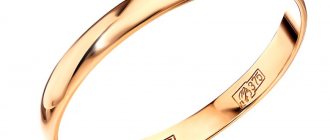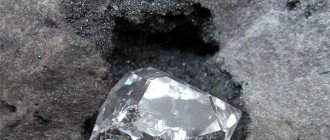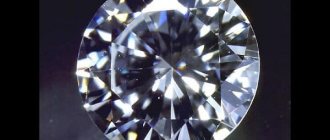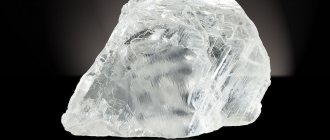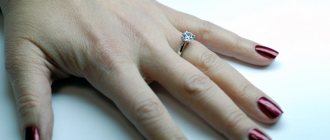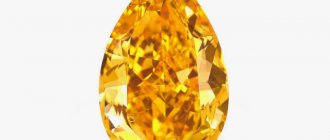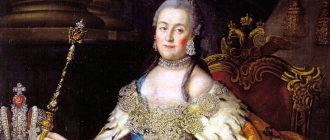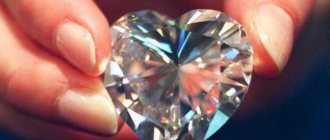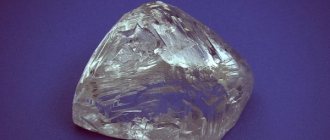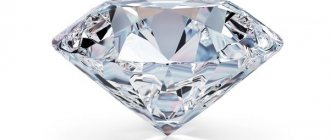The one and only diamond “Shah”
The history of the Shah diamond begins in the mid-16th century.
from the mines of the Islamic Golconda Sultanate. For reference: Diamond is distinguished from other precious stones by inscriptions on the edges made by owners in different eras.
View this post on Instagram
Posted by Afalina (@afalina_afalina) Apr 18, 2021 at 8:17 am PDT
Having traveled a journey of more than 5 centuries, the unusually shaped diamond was not lost, it was carefully stored and passed on to other owners for various, but often bloody reasons.
Description
The Shah Diamond is a perfectly pure gem weighing more than 80 carats. It has a slightly yellowish tint, which is almost invisible. It has no cut as such. All that the mineral was subjected to was polishing. It has the shape of an octahedron, slightly elongated, with rounded edges.
This is one of the most famous diamonds, which has not only material value, but also historical value. Its cost is only slightly lower than the Orlov diamond.
At all times, interest in the mineral was shown not only because of historical curiosity, but also for the purpose of studying ancient engraving.
Characteristics of the Shah diamond
The treasure of the Diamond Fund of Russia, the Shah crystal has changed several rulers . The stone is 3 cm long, 1.5 cm wide, in the shape of an elongated octahedron. The weight of the 87-carat Shah diamond is 18 grams; before polishing it weighed 95 carats.
The uncut crystal was polished, and the owners engraved their names on it. It has a surrounding groove for a cord that was attached to the canopy of the Shah's throne.
A detailed description of the diamond was given by Professor Alexander Fersman, a mineralogist and crystallographer. In 1922, the scientist studied and characterized the jewelry of the Armory Chamber.
Interestingly, the octahedron is the shape of the classic diamond. When processed, it is divided into 2 parts along the middle fracture, and the 5-sided pyramids familiar in cross-section are obtained.
For reference: Unlike a classic diamond, the “Shah” has an oblong shape with rounded edges - in the schematic image it is a long diamond-shaped prism, the ends of which are blunt and look like pyramidal planes (domatic).
There are no typical middle breaks. Fersman identified 15 facets on the stone, 8 of which are natural, the rest from manual processing.
The ideal transparency of a diamond contributes to the shimmer of light and the play of all colors of the spectrum .
The professor noted a yellowish tint, which is due to the structure of the surface layer. The diamond layers are cut through by scaly plates, reflected on the facets by thin arcs, as well as internal microcracks.
"Shah" in Russia
In 1829, a tragic event occurred in Tehran: the Russian ambassador to Persia, Alexander Griboedov, who had shortly before gained fame as an outstanding playwright by writing the play “Woe from Wit,” was torn to pieces by religious fanatics. The ambassador stood up for the Armenian women, which aroused the anger of the crowd, and as a result he was killed in his own home.
To make amends to the powerful Russian Tsar, the Shah of Persia sent an embassy to St. Petersburg with many valuable gifts, including an incredibly large uncut diamond. Nicholas I graciously accepted the gifts, and since then the diamond, which received the name “Shah,” remained in Russia - first in the Winter Palace, and then in the Moscow Armory.
Currently, the unique jewel is kept in the Diamond Fund, where anyone can see it among other exhibits.
Origin of the diamond
A stone of an unusual shape was found in the Golconda mines, located in Central India, in the middle of the 16th century. But according to the records of the French merchant and traveler Jean Baptiste Tavernier, it is known that the Golconda mines were developed during his trips, that is, in the middle of the 17th century, 1630–1660.
Taking as truth the statement of a famous traveler and a person associated with Indian precious stones, we can assume that “Shah” was found in another mine in gem-rich India.
Who owned the Finger of Allah diamond?
The main historical periods of diamond:
- from the middle of the 16th century to 1591 - Burhan II, Sultan of the province of Ahmednagar, India;
- from 1595 to 1739 - dynastic treasure of the Great Mughals;
- from 1739 to 1829 – kept by the padishahs of Persia;
- from 1829 to 1917 - the relic is transferred to the treasury of the Romanov imperial family;
- from 1917 to 1922 – the Moscow Kremlin, the jewel of the Soviet state;
- from 1922 to the present - one of the exhibits among the large precious stones of the Diamond Fund of the Moscow Kremlin.
Since ancient times, diamonds have been valued for their hardness, purity, and endow the owner with intelligence, courage and determination. But the yellowish diamond found in Golconda, due to the prejudices of the Indian rulers, was not in favor and was sold for a small price to the Ahmednagar Sultanate in the south of the Hindustan Peninsula.
The Muslim ruler Burhan II appreciated the diamond for its shape and attractive shine, and considered the color to be good luck, and named it “Finger of Allah.”
Relic of the Mughal dynasty
The second owner becomes Akbar , the third padishah of the Mughal Empire, grandson of the founder of the dynasty Babur. The ruler's conquests significantly expanded the borders, which included the northern and central regions of India.
In 1595, Baburid conquered the province of Burhan II. The “Finger of Allah” diamond passes to him and becomes another relic of the untold wealth of the Mughal dynasty.
Half a century later, Shah Jihan, Akbar's grandson, sets his sights on the diamond , having ascended to the throne after a series of bloody uprisings against his own father.
Khan became a ruler who went down in history not only by expanding his borders. One of his unique legacies has survived to this day and has become the adornment of India. This is the Taj Mahal mausoleum, dedicated to his beloved wife Mumtaz Mahal.
In 1658, Alamgir I, or Aurangzeb, the son of Shah Jihan, took over the dynastic rule of the empire.
In 1665, Jean Baptiste Tavernier visited him. The inventory of wealth and treasures he compiled mentions a throne made of pure gold under a canopy, inlaid with multi-colored stones, enamel and with figurines of peacocks.
Placers of jewels sparkled on the feathers of birds . Their flowing tails served as the backrest of the throne. The canopy was decorated with stones.
Among them there was also a place for the “Finger of Allah”, suspended on a cord of gold or silk threads, so that the ruler could see the diamond in all the splendor of sparkling and iridescence.
It was for the suspension that a circular groove was drawn.
The Peacock Throne was created during the life of Shah Jihan.
But Tavernier’s descriptions and the images of the ruler sitting on the throne that have survived to this day indicate that the merchant, blinded by the imperial splendor, could have described him incorrectly.
Portraits indicate that peacocks decorate the canopy, but the back is missing.
Diamond history
Shah Diamond
The famous “Shah”, like the Hope Diamond, “Orlov” and most of the largest antique diamonds come from India, as do most of the world’s most famous diamonds. “Orlov” differed from its Indian counterpart in having a “lighter” reputation, which cannot be said about “Shah,” whose entire history is rich in bloody events. Contrary to Indian traditions, it has not 6, 8 or 12 sides, but 15, its shape is far from ideal, and its color is not white . Such a diamond did not seem outstanding to the Indians, and they sold it to the Sultan of Ahmednagar, a state in the west of Hindustan.
The ruler of Ahmedagar was Burkhan the Second, who was a devout Muslim. He cared little about Hindu beliefs regarding stones, and a large diamond, similar to a finger, seemed to him to be the ideal creation of Allah. The name of Burhan the Second was the first of three engraved on the smooth surface of the stone.
Topic: How diamonds are formed
The court master figured out to engrave an inscription on the hard surface of the diamond using another diamond, since no other substance in the world could scratch the stone. Taking diamond chips onto the thin tip of a needle, lubricated with oil, the master carefully scratched out the name of the Sultan. The inscription, the result of long and painstaking work, reads: “Burkhan the Second Nizam Shah. 1000 year" . In terms of European chronology, it was 1591, which allows us to accurately calculate the age of the “Shah” - 425 years.
The “Shah” did not stay with the Sultan for long - four years later, Ahmadnagar was conquered by warlike neighbors - the Great Mughals. Akbar, a descendant of Tamerlane, appropriated the famous diamond for himself along with many other jewelry.
The stone would have gathered dust in the treasury for a long time if 40 years later it had not caught the eye of Jihan Shah, the grandson of Akbar, who was also a good lapidary. He cut many gems with his own hands. According to some experts, the polishing of the Shah diamond was also his doing. At the behest of Jihan Shah, the diamond was decorated with a new inscription that read: “Son of Jihangir Shah Jihan Shah, 1051.” The year was 1641.
The second inscription differs from the first in greater skill and beauty. The fate of Jihan Shah was not so beautiful; he died as a prisoner in the Agrin fortress in 1666, overthrown by his own son Alamgir. Later he will be known to the world under the name Aurang-Zeb.
Before being lost for 150 years, "The Shah" was described in 1665 by the Frenchman Jean Baptiste Tavernier. The merchant described in detail many famous Indian diamonds and the decoration of the Shah's palace. The diamond was part of the "Peacock Throne", it hung on a silk thread from the canopy, and the throne itself was decorated with hundreds of precious stones - rubies, sapphires and emeralds of the best quality.
Topic: Black Diamond
Later, the famous diamond appeared in Iran. The diamond entered the treasury when Nadir Shah, the ruler of Iran, conquered Northern India. In 1747, the Shah was stabbed to death by conspirators, and civil strife began in Iran. The next Shah was the founder of the new Qajar dynasty, Agha Muhammad Khan. Since the new ruler was a eunuch, he appointed his nephew, known in the future under the name of Fath Ali Shah, as his successor. At his order, a third inscription was made on the diamond in honor of the anniversary of his reign.
"The Qajar Lord Fath Ali Shah Sultan, 1242." The engraving was made in 1824.
Diamond goes to the Persians
By 1739, tiny provinces remained of the Indian territories over which the Great Mughals reigned supreme. The Persian commander Nadir Shah reduced the areas of the state by sacking Delhi and seizing lands west of the Indus River (Sindh, Peshawar and Kabul).
It was he who took away the Peacock Throne and the Mughal treasury along with the Finger of Allah and Koh-i-Noor diamonds . The treasures of the Baburids were taken out on 21 camels: about 2 tons of gold, about 5 tons of diamonds, priceless emeralds and rubies. The pearls were loaded into the caravan without being counted or weighed.
In Persia, the trace of the Peacock Throne was lost with the death of Nadir Shah in 1747. Some claim that the relic was captured by the Kurds, dismantled and sold, other sources write that its parts were used to make Persian “peacock” thrones.
“Finger of Allah”: the price for the death of ambassador and writer A.S. Griboyedova
On January 30, 1829, in Tehran, religious fanatics destroyed the representative office of the Russian
empires.
During the attack, a talented diplomat and ambassador, writer Alexander Griboyedov was killed. One person survived from the mission.
It is interesting that the story of Khozrev Mirza, the padishah’s heir, presenting Emperor Nicholas I with a rare diamond from the Baburid dynasty as a sign of apology and compensation for the death of the writer appeared after the publication of Yuri Tynyanov’s novel “The Death of Wazir-Mukhtar” (1927–1928 edition).
The Russian autocrat did not ask for any money or diamonds for the death of Griboyedov, but demanded recognition of guilt and repentance for the murder of representatives. In the spring of 1829, the Prince of Persia visited Emperor Nicholas I. The purpose of the visit was to reduce the indemnity under the Turkmanchay Treaty of 1828.
The padishah's court was able to collect only 8 of the declared 10 kururs of recovery, which amounted to about 20 million rubles. Abbas Mirza decided to fill the missing amount with the “Finger of Allah” diamond, ancient manuscripts, carpets, precious stones, and horses. The Emperor forgave Persia the remainder of the payment and even presented the diplomatic mission with royal gifts.
Two concubines and a eunuch
But the cup of patience was filled with something else - two women who had escaped from Allayar Khan’s harem and the Shah’s eunuch Yakub Markarian took refuge in the Russian mission.
As he noted in his book “Persia - Iran. Empire in the East,” writer and publicist Alexander Shirokorad, one of the fugitives was Armenian, and the second was German. They were both taken from their native places against their will and actually became the property of Allayar Khan, who was the son-in-law of Feth Ali Shah himself. Since after the capture of Yerevan the territory of Armenia became part of the Russian Empire, the women and the eunuch hoped for the help of A.S. Griboedova. The noble nobleman could not refuse people who asked him for protection, which was perceived by many Iranians as a flagrant violation of Sharia law. The British, who in every possible way opposed the growing influence of Russia in the East, skillfully fueled public indignation. Tehran's spiritual leader, Mirza Masih Astarabadi, called on Muslims to severely punish the “infidels” who openly violate Islamic traditions.
According to I.V. Bazilenko, Mirza Masih acted on the instructions of the British, because researchers have established that Ambassador John MacDonald appealed to the government of his country with a request to allocate funds for gifts for this spiritual leader.
The Shiite theologian, loyal to the British, actively called on the Iranian leadership not to follow the Turkmanchay Peace Treaty, not to release prisoners of war to Russia, and also blessed the attack of his supporters on Russian diplomats.
In this situation, Feth Ali Shah did nothing to protect the ambassador and his staff. Probably, the ruler did not want to complicate relations with Allayar Khan and religious fanatics or was afraid that the eunuch Yakub Markaryan, who served as treasurer at the Shah’s court, would reveal some political secrets to the Russians.
Some researchers believe that the tragedy was provoked by a difference in mentality. For some, this was an attempt to protect unfortunate women and a castrated fugitive, and for others, it was a mortal insult and a violation of religious laws. One way or another, as I.V. pointed out. Bazilenko, together with A.S. Griboyedov killed 7 diplomatic mission employees, 30 servants and 16 Cossacks.
Origin of the engraving on the surface of the Shah diamond
Sergei Oldenburg, academician and orientalist, deciphered the ornamental inscriptions on the diamond. Alexander Fersman compiled their detailed description and chronology of application.
Ahmadnagar
Research has revealed the origin of one of the engravings, indicating Shah Burhan Nizam II, the first owner of the stone.
The year 1000 according to the Muslim calendar, if translated into Gregorian, then 1592. The drawing is simple and restrained.
The depth of the engraving indicates the painstaking work of the jeweler - the work requires perseverance and time. Hand engraving took several years. A thin needle was dipped in fat and diamond powder. Using the wax applied to the face of the diamond, the engraver scratched the design, just as glass is now cut with a “diamond knife.”
Mughal
The heyday of the mighty Mughal state is immortalized by ornate patterns denoting the second owner - Jehangir Shah Jehan. According to Muslim chronology, 1051 corresponds to 1642 of the modern calendar. The precious diamond was polished and lost 6.3 carats.
Some sources claim that part of the inscription was made by the hand of the ruler, who loved to spend his free time on the art of engraving and cutting precious stones. The groove, made in a circle, also required attention and a lot of work, which speaks of the skill of the jewelers and engravers of India in the 17th century.
Persian
Almost a century passed before the 3rd engraving appeared on the diamond in 1827.
The Persian ruler celebrated the 30th anniversary of his accession to the throne, the name of the Qajar ruler Fathali Shah Sultan was inscribed in Arabic script. A drawing is a full-fledged graphic image.
The techniques for executing the second and last inscriptions could be identical : scientists of the last century suggested that iron cliches with a mirror image were pressed to the plane of the diamond using clay.
Then the workpiece was placed in a ceramic dish filled with coal. The vessel was heated using blacksmith's bellows. The iron became hot and left a mark on the hard surface of the crystal. The procedure was repeated several times until an image of the required depth and clarity was obtained.
Who found it
According to the inscription left by its first owner, the stone rightfully belongs to Burhan the Second, who ruled in Hindustan. He really liked the unusual diamond, shaped like a small finger, and, contrary to Hindu beliefs, he decided to place it in his personal collection, engraving his name with another diamond.
We also recommend reading:
The history and curse of the Kohinoor stone The marvelous ametrine stone Characteristics of larimar and its main properties Selection of stones by date of birth
